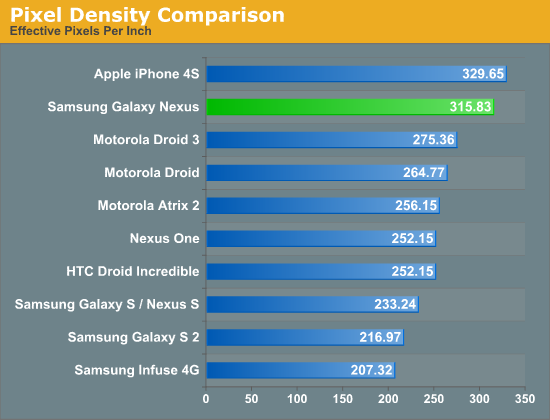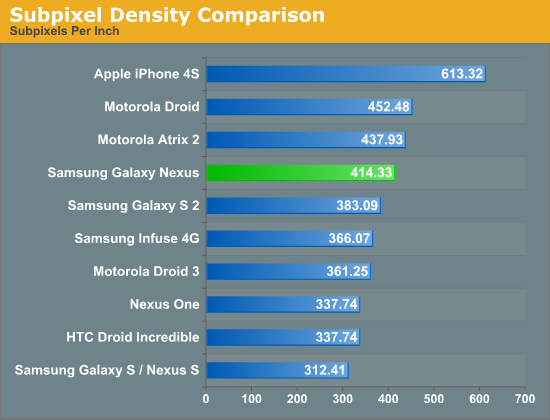Confirmed: Galaxy Nexus Includes PenTile
by Brian Klug & Jason Inofuentes on October 21, 2011 12:58 AM EST- Posted in
- Smartphones
- Samsung
- Ice Cream Sandwich
- Mobile
- AMOLED
- galaxy nexus
Though we've learned a lot about the Galaxy Nexus specifications already, one of the things that has remained a question thus far is whether its 4.65" 720p HD Super AMOLED display uses an RGB subpixel rendering layout or PenTile. We've now confirmed that the Galaxy Nexus display does in fact use RGBG PenTile, like all the Nexus devices to date. This isn't super surprising considering that Samsung has been pretty good about adhering to all the monikers it has gradually been tacking onto AMOLED. There are a number so far - 'super' connotes an optically bonded panel and digitizer stack, 'plus' connotes an RGB stripe, and now 'HD' connotes, well, 720p. HD Super AMOLED lacks Plus, and thus isn't an RGB stripe.
The next question is just what 4.65" HD Super AMOLED will look like, or whether the presence of PenTile will be as noticeable as previous AMOLED phones like the Nexus S / Galaxy S or Nexus One where it was arguably very noticeable. That said, at some subpixel density it should become difficult to impossible to notice PenTile's presence, it's just a matter of exceeding human visual acuity. Having not seen the Galaxy Nexus in person yet and given the absence of good macro shots of the display, we have put together a numerical comparison pitting the Galaxy Nexus panel up against some other common smartphone displays.
First up is a quick plot of the effective pixel density of some popular displays. Stated another way, this is the pixel density based on the manufacturer's stated logical resolution, which is also the resolution of Android's render target for the phone.

Note that this is the traditional means of reporting pixels per inch that we've published before. However, using this metric is just a bit misleading since it doesn't take into account the difference between 2 subpixel-per-pixel RGBG or RBGW PenTile versus the 3 subpixel-per-pixel RGB stripe. To make for an effective comparison, we've put together another plot where we take into account the presence of PenTile and report subpixel density.

Here things still look pretty good for the 4.65" HD Super AMOLED display, putting it just north of SGS2's Super AMOLED Plus display with an RGB stripe. I wager that if you were satisfied with the pixel density of SGS2 that the pixel density Galaxy Nexus actually won't be off-putting despite the presence of PenTile. In addition, hopefully some of the UI design considerations that come along with using PenTile (no vertical 1 pixel thick elements) have been taken into consideration from the outset for Ice Cream Sandwich. For true subjective impressions however, we'll have to wait and see.
Source: Data










152 Comments
View All Comments
sjael - Friday, October 21, 2011 - link
(And just before Brian gets on my ass about my first statement, yes, I actually looked at it in my head about three seconds after clicking Post and realised how he did it :P)Brian Klug - Friday, October 21, 2011 - link
See my above two replies where I outline how the actual subpixel resolution of a display is not simply a scalar multiple of the effective pixel density.Also, explain how it is not fair to compare RGB PenTile to RGB based on the true subpixel density of the two displays? Most people complain that in either of the PenTile schemes, they can see the subpixels when shown solid colors. Thus the normal pixel density comparison as a function of effective resolution is not a fair means of comparison since it's predicated on there being three subpixels per pixel (and judged accordingly).
True, PenTile does draw at the subpixel level, but the framebuffer that the PenTile driver is looking at effective resolution. I don't disagree that it won't look any worse than a qHD display, the point is that 720p PenTile shouldn't be nearly as distracting as other RGBG AMOLED panels we've seen before (eg Nexus One/Nexus S which are near the bottom).
-Brian
thegadgetlife.com.au - Friday, October 21, 2011 - link
Green is more related to the the perceived brightness than level of detail as I understand.For level of detail, if you have a one pixel width white line for example, there isn't much clever pentile rendering can do about it as individual pixels in the pentile layout simply can't show the colour white (or gray or really any colour that has no zero values in the RGB triplet)
sjael - Friday, October 21, 2011 - link
They use more green sub-pixels because visual acuity peaks in green. Thus having more green subpixels allows the display to have basically the same perceived resolution (as RGB) in any color containing green. They cut out half the blue and red ones because we see less detail in blue and red, so for most purpose we don't notice their absence.It's quite a bit more complicated than that, but that's the basic principle as I see it. (See what I did there? :P)
grkhetan - Friday, October 21, 2011 - link
When is iPhone 4S review going out?imaheadcase - Friday, October 21, 2011 - link
Just read a regular iphone review.Brian Klug - Friday, October 21, 2011 - link
When it's finished :PBy the end of this week most likely, no later than Sunday.
-Brian
thegadgetlife.com.au - Friday, October 21, 2011 - link
Let me think about this, but I have a feeling you are wrong.There is an effective change in vertical resolution as well.
for example, the SGS 2 with an RGB layout in subpixel terms is
800*3 X 480 *3 NOT 800*3 X 480
There is a change in vertical density as well, because each pixel contains subixels, not just vertical ones.
Take a 2x2 one square inch screen.
RGB layout:
RGB RGB
RGB RGB
that's 4ppi or 12 subpixels per inch (call it spi)
RGBG pentile layout:
RG BG
RG BG
that's 4ppi or 8 spi
Unless my understanding of what ppi means is wrong, but I don't think it is.
Brian Klug - Friday, October 21, 2011 - link
You are partially right and partially wrong, and you're still missing the point that there is not a vertical change in resolution between the two, and that your scaling of PPI by 2 or 3 does not represent the subpixel density. The problem isn't in your diagram or understanding, it's in the fact that you turn around and just scale PPI by some scalar instead of actually doing the math yourself, and no, it is not 800 * 3 x 480 * 3.Again, what you're doing when you're setting up 800 * 3 x 480 * 3 is
RGB RGB
RGB RGB
RGB RGB
RGB RGB
RGB RGB
RGB RGB
for one
| |
| |
If you look at the actual subpixel, you'll notice that it is in fact
RGB RGB
RGB RGB
again, the vertical resolution is unchanged between RGBG and RGB. The two subpixel rendering schemes are 2, 3 respectively in horizontal space.
Another example that might help this click, look at nuovoyance's own diagram: http://www.nouvoyance.com/images/rgb-v-rgbw-circle... then count the number of horizontal pixels in both. Note that the height of each subpixel is unchanged.
-Brian
doobydoo - Saturday, March 17, 2012 - link
Again, Brian, look at this example.For RGB - you drew 12 sub pixels for a 2 x 2 pixel display.
Which is 3x the number of pixels.
You are correct that only the horizontal number if amended, which is why we only multiply by 3, and not by 9 (if a pixel was made up of a 3 x 3 array we would have 9 sub pixels for every pixel).
But you haven't multiplied by 3 in your table (for the iPhone). You should have.